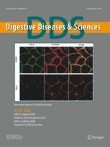
Abstract
Background
Microscopic colitis (MC) is a subtype of inflammatory bowel disease (IBD) with overlapping risk factors for low bone density (LBD). While LBD is a known complication of IBD, its association with MC is not well-established.
Aims
Assess the prevalence of LBD in MC compared to control populations, and evaluate if MC predicts LBD when controlling for confounders.
Methods
Retrospective, observational case control study of adult patients with pathologically confirmed MC from 2005 to 2015. Bone density measurements were abstracted from dual-energy X-ray absorptiometry (DEXA) reports, and bone density was classified using T-score: normal (T ≥ − 1.0), osteopenia (− 1.0 > T > -2.5) or osteoporosis (T ≤ − 2.5). Demographics, disease, medication history and LBD risk factors were obtained from chart review. Prevalence of LBD was compared to national and local controls. A matched control cohort to MC patients without prior diagnosis of LBD was analyzed with logistic regression to assess the relationship of MC to LBD.
Results
One hundred and eighteen patients with MC were identified. Osteopenia in women with MC was more prevalent compared to national controls (67% vs. 49%, p = 0.0004), and LBD was more prevalent in MC patients compared to local controls (82% vs. 55%, p < 0.0001). In MC patients without prior diagnosis of LBD matched to controls, there was a higher prevalence of osteopenia (53.2% vs. 36.7%, p = 0.04). However, after controlling for confounders, MC was not associated with LBD (OR 0.83, 95% CI 0.22, 3.16, p = 0.8).
Conclusions
While LBD was more prevalent in MC patients compared to control populations, with adjustment for key confounders (including BMI, steroids, smoking, vitamin D and calcium use), MC was not an independent predictor of LBD.



